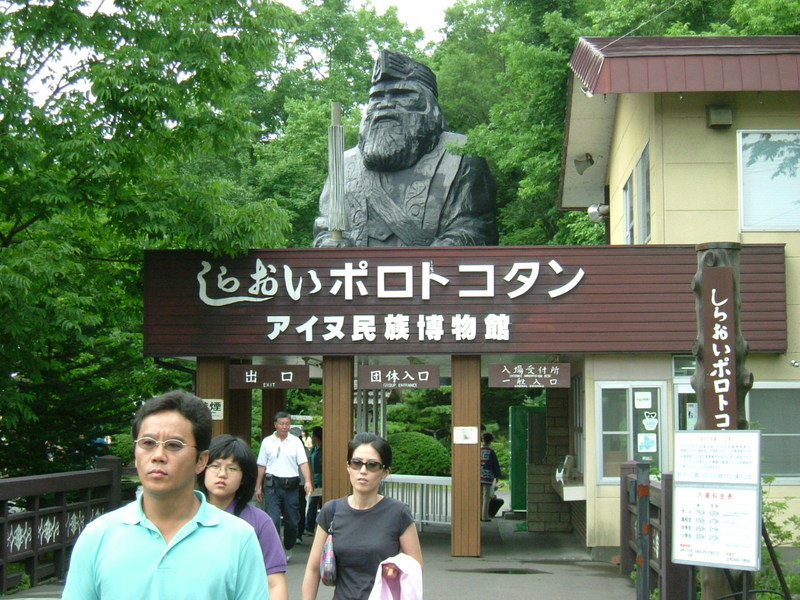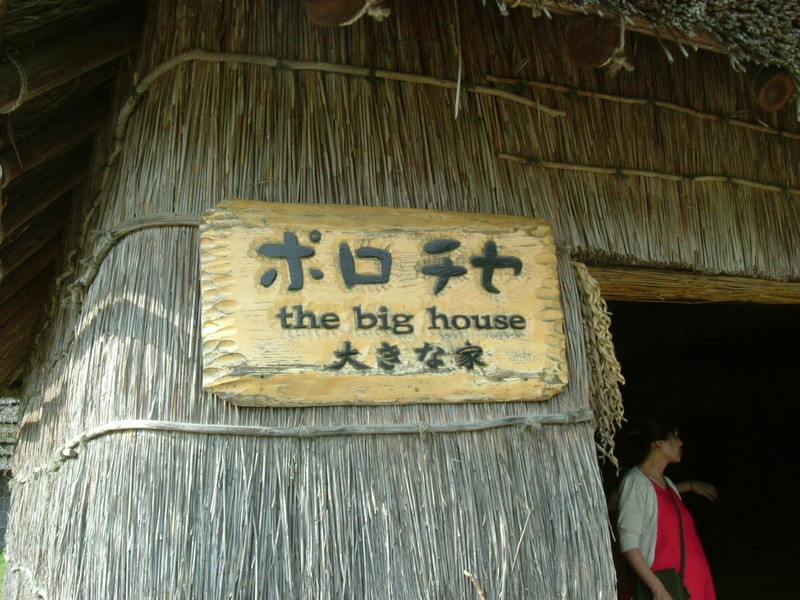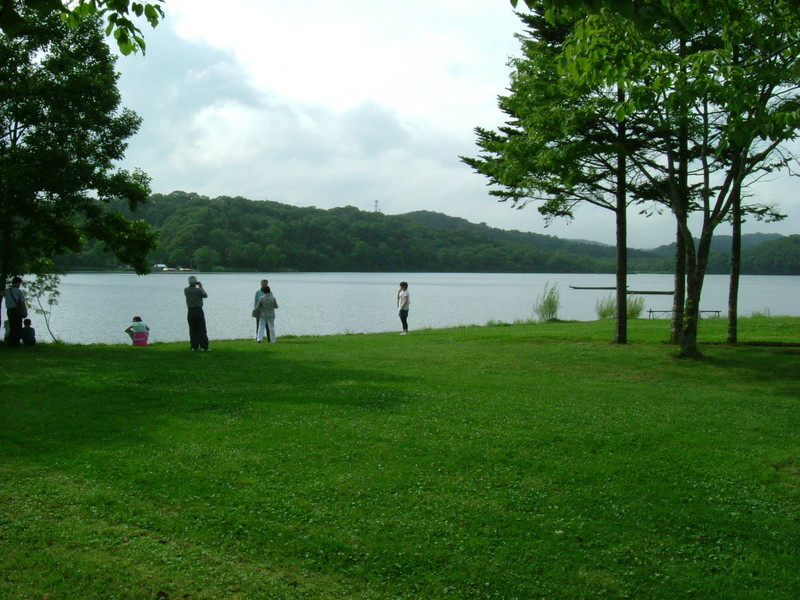About twenty years ago the Japanese Prime Minister at the time, Mr. Nakasone, announced a controversial comment that Japan is ethnically homogeneous though the U.S. is a multicultural country. The drift of his argument was like this:
The U.S. government has always had some difficulties to carry out their policies because of the influx of illegal aliens who are in most cases uneducated. On the other hand, the Japanese are a single race and medical services, welfare and education are being equally done all over the country in Japan.....
As mentioned above, he was accused of not knowing about the Ainu. Lots of critics told of the Ainu living in Japan and it's not good that the Prime Minister didn't know about it. The Ainu was also mentioned in the fundamental primary school textbook of history and I had heard of the Ainu. I thought it was just a history, however, I was surprised to know that Ainu is alive and exists today.
Ainu is one of the northern peoples. They were living on the eastern coast of Russia, Sakhalin, the Kuril Islands and Hokkaido since far before the Japanese went to Hokkaido. That is to say, they were the indigenous people of Hokkaido. Old records reveal that they lived in the north of Honshu (main island of Japan) too.
According to the story from a guide to POROTOKOTAN, the Ainu and Japanese got mixed at least before the middle of the Edo era. The guide was an eldery gentleman who looked to be in his early 70's and he seemed to be the 6th generation of the mixture of Ainu and Japanese. I heard lots of things about the Ainu from him.
I imagined and expected to be able to see the Ainu village here at Porotokotan. In other words, I took Porotokotan as a real Ainu village. However, it was just an illusion. The real Ainu, leading a quiet Ainu life, don't exist now. Porotokotan was just a museum or amusement facility though I'd like to see a real life presentation like that of the Amish. I was disappointed that there is no genuine Ainu life now.
Even young people who have Ainu ancestors don't use the Ainu language in daily life and they work hard to learn it just to preserve the Ainu culture. A dozen employees of Porotokotan wear the ethnic costumes and entertain us, but they live as Japanese outside Porotokotan and put on the native dress only during their business hours.
At this point Mr. Nakasone's comment that I introduced at the beginning of this entry was not totally wrong. Ainu is almost completely fused with Japanese now.
I took more than fifty pictures here for the rest of my family. I chose and show you some of them. At first, let me explain the name Porotokotan. More than 90% of names of places in Hokkaido are named from the Ainu language. "PORO" of Porotokotan stands for big. Likewise, "TO" means lake and "KOTAN" means lakeside. Totally, Porotokotan means the lakeside of a big lake. I think you know the biggest city in Hokkaido is Sapporo. "PORO" of Sapporo means "big" too.
 This picture shows the entrance of Porotokotan. Tourists have to go through the shopping street to get here and the same going back to the parking lot. When I walked here on the way to the entrance, I was going to buy something for a souvenir on the way back, but I didn't get anything here when I returned to the parking lot. I heard in the museum that there are no Ainu leading the Ainu life. That means,,, who made these folkcraft articles? I didn't ask this question there, but the folkcraft must have been made by machine, not by the hands of Ainu.
This picture shows the entrance of Porotokotan. Tourists have to go through the shopping street to get here and the same going back to the parking lot. When I walked here on the way to the entrance, I was going to buy something for a souvenir on the way back, but I didn't get anything here when I returned to the parking lot. I heard in the museum that there are no Ainu leading the Ainu life. That means,,, who made these folkcraft articles? I didn't ask this question there, but the folkcraft must have been made by machine, not by the hands of Ainu.
 My digital camera is old and doesn't have a wide angle lens. I'd like you to see the huge sculpture in the 1st and 2nd pictures. I couldn't shoot the whole image in one time. I think you can imagine how big it was, compared with the size of the people. You can see only the base of the sculpture in this picture. The sculpture is a kind of God for the Ainu and was built praying for the happiness of all the visitors.
My digital camera is old and doesn't have a wide angle lens. I'd like you to see the huge sculpture in the 1st and 2nd pictures. I couldn't shoot the whole image in one time. I think you can imagine how big it was, compared with the size of the people. You can see only the base of the sculpture in this picture. The sculpture is a kind of God for the Ainu and was built praying for the happiness of all the visitors.
 This picture was shot from the pier. I hope you can figure out the atmosphere of Porotokotan. As you can see, Ainu houses were arranged here and I entered one of them. As soon as I entered the house, I felt something strange or not right. Do you remember the houses that I showed you at the historical village of Hokkaido? See the 5th-7th pictures of this entry: http://kumo.typepad.jp/weblog/2007/08/historical-vi-1.html
This picture was shot from the pier. I hope you can figure out the atmosphere of Porotokotan. As you can see, Ainu houses were arranged here and I entered one of them. As soon as I entered the house, I felt something strange or not right. Do you remember the houses that I showed you at the historical village of Hokkaido? See the 5th-7th pictures of this entry: http://kumo.typepad.jp/weblog/2007/08/historical-vi-1.html
The climate of Hokkaido is extremely severe, especially in the winter. Winds must have been so strong. Did Ainu people have the technique or method to build such a big and strongly structured house? I asked this question to my guide. He replied that these houses were not built by Ainu people and were of no importance historically. It's just for the exhibition and performance. The size of the houses seemed to be more than ten times as big as the real Ainu houses.
 This is the entrance of one of the houses. The name of this house is written in three languages on the signboard. The upper line is written in the Ainu language, the middle is English and the lower is Japanese. In this house, I was given a lesson about the history and daily life of the Ainu from a member of staff. There were about 200 tourists in the house, but mostly Korean. Though the Korean group had an interpreter the speaker himself added some Korean words in his talk and his speech was interesting and very enjoyable. If allowed, I wanted to hear the story about the forced migration by Stalin just after World War Two, though the speaker might have intentionally wanted to avoid the political story. The Ainu people were forced to move from Sakhalin to Hokkaido by the Soviets. If the Korean people had heard that story, they would feel sympathy with the Ainu because Korea had just the same experience.
This is the entrance of one of the houses. The name of this house is written in three languages on the signboard. The upper line is written in the Ainu language, the middle is English and the lower is Japanese. In this house, I was given a lesson about the history and daily life of the Ainu from a member of staff. There were about 200 tourists in the house, but mostly Korean. Though the Korean group had an interpreter the speaker himself added some Korean words in his talk and his speech was interesting and very enjoyable. If allowed, I wanted to hear the story about the forced migration by Stalin just after World War Two, though the speaker might have intentionally wanted to avoid the political story. The Ainu people were forced to move from Sakhalin to Hokkaido by the Soviets. If the Korean people had heard that story, they would feel sympathy with the Ainu because Korea had just the same experience.
 I took a picture of an ethnic Ainu dance, but their movement was so fast. The picture is what you see. We were sitting on the front row. A, my daughter, was always away from me. She was sitting 1.5 meters apart. There was room for about two people to take the seats between us. A Korean man seemed to want his daughter to sit between us from a casual glance backwards. I tried to say "Do you want your daughter to sit here?" in Korean, but I couldn't. My Korean was no use in the extreme situation that requires the exact words. My words were "앉으세요" meaning "Take a seat please!" It was not wrong, but wasn't exactly what I wanted to say. I explained that the girl was my daughter and she didn't like me and was sitting apart with my poor Korean skills. I hope he really understood me. At any rate, the words are kind of tools to communicate with each other. If you can't use the tool at the moment you want to use it, the tool is no use at all. I realized that reading the grammar book slowly at the desk is not sufficient to enjoy chatting in Korean. It was a good opportunity.
I took a picture of an ethnic Ainu dance, but their movement was so fast. The picture is what you see. We were sitting on the front row. A, my daughter, was always away from me. She was sitting 1.5 meters apart. There was room for about two people to take the seats between us. A Korean man seemed to want his daughter to sit between us from a casual glance backwards. I tried to say "Do you want your daughter to sit here?" in Korean, but I couldn't. My Korean was no use in the extreme situation that requires the exact words. My words were "앉으세요" meaning "Take a seat please!" It was not wrong, but wasn't exactly what I wanted to say. I explained that the girl was my daughter and she didn't like me and was sitting apart with my poor Korean skills. I hope he really understood me. At any rate, the words are kind of tools to communicate with each other. If you can't use the tool at the moment you want to use it, the tool is no use at all. I realized that reading the grammar book slowly at the desk is not sufficient to enjoy chatting in Korean. It was a good opportunity.
 A is eating soft ice cream at the POROTO (big lake) lakeside.
A is eating soft ice cream at the POROTO (big lake) lakeside.
As I wrote above, there were many Korean tourists in Porotokotan, but there were few foreign people in the historical village of Hokkaido. Porotokotan is not a historical heritage site but an amusement facility, whereas in the historical village there are many real houses that were actually used. I wondered why the Korean group chose to come here, not the historical village?
(Vocabulary)
drift of an argument 論旨
indigenous 〈人・慣習・文化などが〉 (土地)固有の, 土着の
Amish 《複数扱い》 アーミッシュ (非常に厳格なキリスト教の一会派
use ~ at the moment one wants to use it ~を使いたいときに使う
at a casual glance 何気なく見ると
(KW: ポロトコタン アイヌ民族博物館)

Comments